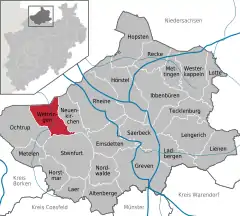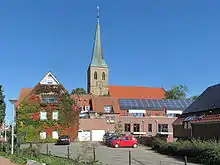Wettringen (Münsterland)
Wettringen is a village and a municipality in the district of Steinfurt, in North Rhine-Westphalia, Germany.
Wettringen | |
|---|---|
 Coat of arms | |
Location of Wettringen within Steinfurt district  | |
 Wettringen  Wettringen | |
| Coordinates: 52°12′30″N 7°19′00″E | |
| Country | Germany |
| State | North Rhine-Westphalia |
| Admin. region | Münster |
| District | Steinfurt |
| Government | |
| • Mayor | Berthold Bültgerds (CDU) |
| Area | |
| • Total | 57.2 km2 (22.1 sq mi) |
| Elevation | 49 m (161 ft) |
| Population (2019-12-31)[1] | |
| • Total | 8,261 |
| • Density | 140/km2 (370/sq mi) |
| Time zone | UTC+01:00 (CET) |
| • Summer (DST) | UTC+02:00 (CEST) |
| Postal codes | 48493 |
| Dialling codes | 02557 |
| Vehicle registration | ST |
| Website | www.wettringen.de |
Geography
Wettringen is situated on the river Steinfurter Aa. It is located in the region Münsterland, approx. 40 km north of Münster and approx. 25 km east to the Dutch border.
Division of the town
Wettringen consists of multiple smaller districts:
|
|
History
Wettringen was first mentioned in 838. A historical document says that in 838 Kaiser Louis the Pious donated the church of "Wateringas" to the nun monastery of Herford. This romanesque church was founded in 800 by Charlemagne. It was reconstructed in 1522.
In 1590, during the Dutch Revolt, Spanish Troops plundered Wettringen multiple times. In 1622, during the Thirty Years' War Wettringen was the victim of plunder and pillage again.

In 1771 the "Münster Canal" was extended from its former end Clemenshafen in Neuenkirchen to its new end in Maxhafen. It was renamed to "Max-Clemens Canal" after the prince-bishops Maximilian Frederick of Königsegg-Rothenfels and Clemens August of Bavaria. The original plan was a connection between Münster and the Dutch Town of Zwolle, but the last segment was never completed. In 1840 shipping on the canal was given up due to being uneconomic.
In 1861 the old church was torn down and the diocese architect of Münster, Emil von Manger from Oelde, started to build a new gothic revival church. It was completed in 1863 and was consecrated to Saint Petronilla. This church still stands today in the village centre.
The Second World War also left its marks on Wettringen. On March 31, 1945, allied troops came to Wettringen. At the end of the year, approx. 1200 fugitives, predominantly from Silesia, found shelter in the village. In memory of the victims of the World War I and II a memorial was built in 1957 and it was complemented by a stele in 1998 to remind especially to the victims of the Holocaust. An old memorial from 1929 had to be removed due to traffic planning.
Coat of Arms
The coat of arms of Wettringen is colored in silver, red and gold, the traditional colors of the Münsterland. At the top is a silver bar with a curved red line in the middle. It is the symbol of the Edelherren of Wettringen. Below that is the red bar taken from the coat of arms of the nun monastery of Herford. At the bottom a swan is shown. This symbol is taken from the coat of arms of the Fürst of Bentheim-Steinfurt.
Main Sights
Buildings
- Beside the Church of St. Petronilla from the 19th century, there is the Ahlers' family farmhouse. This typical westphalian farmhouse is approx. 500 years old. In the 1980s, Wettringen bought this farmhouse from the family Ahlers and moved the building from its old location in Klein Haddorf to its current position in the village centre, being now the oldest building in Wettringen.
- On top of the Rothenberg stands the villa Jordaan. It was built between 1923 and 1925 by Alfred Hensen from Münster and was originally a summer refugium for Bertha van Heek and Jan Jordaan. Today it's the property of the University of Münster and is used for academic meetings and seminars.
Politics
Town council
The town council of Wettringen after the election of May 2014 is split-up as follows:
Mayors
- 1999–2015: Engelbert Rauen
- since 2015: Berthold Bültgerds
Twin towns
Wettringen's twin towns are Fretin (France), the Dutch village Dalen and the German village Gnoien.
References
- "Bevölkerung der Gemeinden Nordrhein-Westfalens am 31. Dezember 2019" (in German). Landesbetrieb Information und Technik NRW. Retrieved 17 June 2020.
External links
| Wikimedia Commons has media related to Wettringen (Münsterland). |
- Official website
 (in German)
(in German)